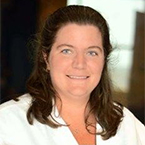By: Kristen Sexson-Tejtel, MD FAAP & Carolyn Altman, MD FAAP
Postural Orthostatic Tachycardia Syndrome (POTS) is a condition caused by a problem with the way the nerves regulate blood flow. As a result, enough blood doesn't go to the right place at the right time.
For example, when a child or teen with POTS stands up (a change in posture), the blood vessels in the legs and feet are overly relaxed and allow pooling of blood in the veins there. This, in turn, decreases the blood flow back to the heart and brain. This can cause dizziness and blurred vision.
To make up for the lack of blood flow, the heart beats much faster (tachycardia). With POTS, there is usually an increase in heart rate by 30-40 points from lying to standing or a standing heart rate of greater than 120 bpm.
POTS often starts around the time of puberty but can develop at any age. About 75-85% of cases are in females. POTS may improve or even disappear in 80% in most people by the time they are in their early 20s. Symptoms sometimes begin after a viral illness, major surgery, or trauma. They often are worse in the morning, making it difficult to get ready for school.
What causes POTS?
POTS is thought to be a disorder of the autonomic nervous system, the part of the nervous system that controls heart rate, blood pressure, movement of food through the gut, sweating, and many other functions. Other factors that can contribute to POTS include dehydration, poor fitness, anxiety, and/or hypervigilance (being much more sensitive to feeling changes in the body).
Symptoms of POTS
POTS causes a variety of symptoms with the heart and blood vessels, including:
Palpitations (the sensation of rapid changes in heart rate or
racing heartbeat)
Chest discomfort
Dizziness, lightheadedness, or fainting (syncope)
Exercise intolerance--feeling too fatigued for reasonable physical activity
Extreme tiredness
Because the autonomic nervous system has such a wide impact throughout the body, other symptoms of POTS may include:
Gastrointestinal (GI) symptoms like nausea, bloating, cramping, vomiting, diarrhea, or constipation
Muscle and/or joint pain
Trouble sleeping (insomnia)
Headaches, especially migraines
Blurred vision
Fuzzy thinking, poor concentration or "brain fog"
Anxiety and/or depression
Cold extremities with reddish/purplish coloration of the feet
Heavy, painful and prolonged menstrual periods
Diagnosing POTS
A thorough history and physical exam are the keys to help your child's doctor make the diagnosis of POTS. They may also recommend some tests, such as:
Orthostatic vital sign measurements including the Active Stand Test are very helpful: the child's heart rate and blood pressure are measured first while lying down, then sitting, and then while standing for 2, 5 and 10 minutes. If the patient is < 19 years old, the test is abnormal if the heart rate rises more than 40 beats above the resting rate by 10 minutes of standing (more than 30 beats is the cut off if older than 19 years). A drop in blood pressure with standing occurs less frequently. The Active Stand Test may bring on the symptoms of POTS.
Electrocardiogram (ECG) is used to rule out other heart problems that can cause racing heart beats.
Other tests that are sometimes needed include:
Blood tests: thyroid function tests, complete blood counts
24 Hour Holter monitor: this device records all the heart beats for 24 hours so the heart rate and rhythm can be examined
Echocardiogram: an ultrasound of the heart to look at the heart's structure and function
A team of specialists may be involved in managing this multi-system disorder. It may include cardiologists, neurologists, gastroenterologists, therapists, psychiatrists, rheumatologists, or endocrinologists.
Treatment for POTS
There is no perfect treatment for POTS. Treatment is individualized to each child's specific symptoms, and recommendations may include:
Increasing water intake to at least 60-80 ounces per day (depending upon the child's size) and an increase in the amount of salt in the diet. Together, these help to retain fluid and fill up the overly relaxed blood vessels.
Getting lots of sleep- up to 10 hours a night.
Sleeping with the head of the bed mildly raised. Over time, this decreases morning symptoms of dizziness as the nervous system is retrained.
Exercising. Gentle workouts at first and gradually increasing to moderate exercise daily. To start, exercises need to be those where the child is not upright, like swimming, recumbent biking, or rowing. Improving leg and core strength improves blood return from the legs. Exercise also improves fitness and energy, and helps to retrain the nervous system over time.
Eating a healthy diet and avoiding skipping meals. Frequent, small meals can be helpful.
Wearing compression stockings.
Avoiding caffeine.
Are there medications for POTS?
Medications are typically considered only for those patients who still have significant symptoms even after trying the above changes in hydration, sleep and exercise. Referral to a pediatric cardiologist or neurologist with expertise in POTS is recommended if medications are needed. A variety of different medications are possible, and must be tailored to the individual child's symptoms. Medications are used to together with, not as a substitute for, the treatments above.
Other types of care for POTS
Because POTS may last for years and can include flare-ups of symptoms, it is easy to become frustrated, anxious, stressed and even depressed. Many families benefit from counseling to help deal with this chronic disorder. Children may require special care plans at school.
More information
About Dr. Sexson-Tejtel S. Kristen Sexson Tejtel, MD, PhD, MPH, FAAP, is a pediatric cardiologist with interest in cardiac imaging and acquired heart disease in children. Within the American Academy of Pediatrics, Dr. Sexson Tejtel is a member of the Section on Cardiology and Cardiac Surgery Publications and Communications Committee. S. Kristen Sexson Tejtel, MD, PhD, MPH, FAAP, is a pediatric cardiologist with interest in cardiac imaging and acquired heart disease in children. Within the American Academy of Pediatrics, Dr. Sexson Tejtel is a member of the Section on Cardiology and Cardiac Surgery Publications and Communications Committee.
|
About Dr. Altman Carolyn Altman, MD FAAP, is Associate Chief of Cardiology at Texas Children's Hospital and Professor of Pediatrics at Baylor College of Medicine in Houston, Texas. She is a leader for the Publications and Communications Committe for the American Academy of Pediatrics Section on Cardiology and Cardiothoracic Surgery. She is also a leader for the Pediatric and Congenital Steering Committee of the American Society of Echocardiography. Dr. Altman is an active member of the Fetal Heart Society, the American College of Cardiology, and the American Heart Association. Her interests include pediatric, congenital, and fetal echocardiography, Kawasaki Disease and other inflammatory cardiac disease, and general pediatric cardiology. Carolyn Altman, MD FAAP, is Associate Chief of Cardiology at Texas Children's Hospital and Professor of Pediatrics at Baylor College of Medicine in Houston, Texas. She is a leader for the Publications and Communications Committe for the American Academy of Pediatrics Section on Cardiology and Cardiothoracic Surgery. She is also a leader for the Pediatric and Congenital Steering Committee of the American Society of Echocardiography. Dr. Altman is an active member of the Fetal Heart Society, the American College of Cardiology, and the American Heart Association. Her interests include pediatric, congenital, and fetal echocardiography, Kawasaki Disease and other inflammatory cardiac disease, and general pediatric cardiology.
|